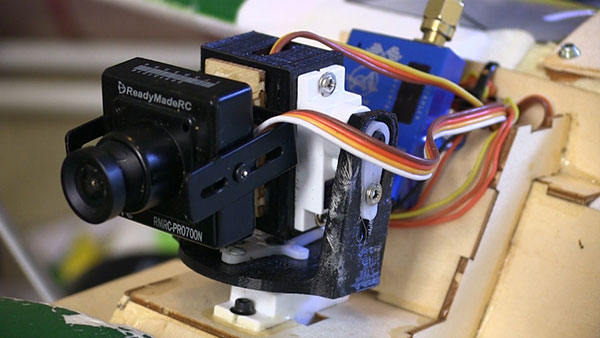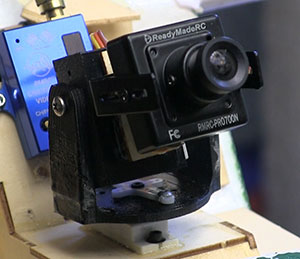



The equipment available today lets us fly fixed wing planes as well as helis.
Text, photos and video by Tom Hintz
Flight Video by Tom Hintz/FatShark
Posted - 6-5-2017
When I decided to try flying my Durafly® ™ Tundra through FatShark Dominator V3 FPV goggles I knew the quality of the camera and video transmitter would be important. If I can’t see clearly my first FPV-only fixed wing flight could be my last. Also, being my first attempt at fixed wing FPV flight could mean that the on-board video gear needed to be tough.
ReadyMadeRC.com had become the go-to source for FlyingRC.net FPV needs so I cruised their offerings and decided on the equipment shown in this Review. Cheap is nice but for this effort I wanted quality and dependability first. The price turned out to pretty good as well.
It was obvious that without a great image from the camera the rest of the FPV gear mattered little. After looking through the camera offerings at RMRC (ReadyMadeRC.com) I chose the MRC-PRO700 700TVL WDR CCD (NTSC).
With over 960 horizontal pixels of resolution, the MRC-PRO700 700TVL WDR CCD (NTSC) is an over-achiever in a world throttled by standard definition video. I figured that the better the video quality coming from the camera the better the video would be in the goggles. That turned out to be true, especially in how the MRC-PRO700 700TVL WDR CCD (NTSC) handles light and specifically changes in light. Too many cameras go brain dead when flying towards the sun. The MRC-PRO700 700TVL WDR CCD (NTSC) stays surprisingly stable because for whatever technical reasons the image coming to the goggles remains clear and the colors vivid. There is no washing out as happens with virtually all my other cameras. That makes it easier to see things in detail, something that is important when trying to miss things with a FPV-only airplane.
Though the MRC-PRO700 700TVL WDR CCD (NTSC) comes from RMRC adjusted to the best all-around settings it can be tweaked to your liking using the buttons on the rear of the camera. Using those buttons, you can adjust contrast, brightness, back light correction, and more. I have dozens of flights on this setup and have yet to see anything in the image quality that needs adjusting. I like out-of-the-box usability that does not require me to find a tech-savvy teenager to use it. I also liked the 5-15V input range that means I can’t accidentally electrocute it with the wrong battery!

My system lets me pan left and right as
well as up and down by moving my head
as I want the camera to move.
by The MRC-PRO700 700TVL WDR CCD (NTSC) uses the industry standard composite video output at 1028 by 508 pixels and 700 TV lines. It has a 3.6mm optic lens, very capable electronic shutter and remarkable light usage that allows more sensitivity so it can use a lower frame rate. That produces some interesting effects when shooting video through a propeller turning at various speeds during a flight.
As is always critical with RC aircraft the MRC-PRO700 700TVL WDR CCD (NTSC) weighs only 1.3 ounces (36 grams). At 1.2”-wide by 1.2”-tall [30 x 30mm] this camera fits in lots of the limited areas many potential FPV models have available for decent mounting.
The MRC-PRO700 700TVL WDR CCD (NTSC) was one of the pleasant surprises in my fledgling foray into FPV flying. The great video quality and zero-need for setup let me plug it in and go flying. I also inadvertently tested its crash worthiness when I put the Durafly® ™ Tundra inverted and the camera pod fell off approximately 80-feet above the field below. It was a little dirty, including the lens that apparently contacted the ground. I was very relieved (and impressed) when the MRC-PRO700 700TVL WDR CCD (NTSC) came to life after plugging it back into the plane and has performed perfectly ever since.
While I did not initially understand the advantages of stable light usage the MRC-PRO700 700TVL WDR CCD (NTSC) repeatedly proved that point when I had to take off into the sun as frequently happens at our field. There is some glare when the sun is in the image but it does not corrupt the rest of that picture. I’m not going to claim to understand why that is but I am glad for that capability. Colors also remain surprisingly consistent in the various light conditions we encounter outdoors. All those image qualities make it easier to me to learn FPV flying.
With a street price of $82.99 (6-5-2017) the MRC-PRO700 700TVL WDR CCD (NTSC) is not a budget breaker, especially when the clarity of the image helps you avoid flying into something lethal to the aircraft. The only down side to the MRC-PRO700 700TVL WDR CCD (NTSC) is now I want to replace all the “included cameras” on my other FPV aircraft…..
The RMRC Cricket Pro Video Transmitter is second in importance only to the camera that feeds it in FPV flying. The versatility of this video transmitter lets us fly in more situations and with more other aircraft without conflict. The RMRC Cricket Pro Video Transmitter transmits on 5.8 GHz using the 40-channels usually associated with FPV flying including the all-important Raceband. To make quick frequency changes possible the RMRC Cricket Pro Video Transmitter has a pushbutton on its face that lets you click through the frequencies quickly.
Another great feature is the selectable transmitting power. A second button on the face of the RMRC Cricket Pro Video Transmitter lets you choose between 25mW, 200mW, 600mW output powers. That lets you dial this video transmitter in for the situation so you can maintain a solid video signal with less chance of blasting the signal of other FPV pilots in the area. This button also turns the RMRC Cricket Pro Video Transmitter On and Off though it also shuts of when the power is unplugged. You must turn it on again for the next flying session.
The RMRC Cricket Pro Video Transmitter uses a CNC machined aluminum case that is both good looking in its anodized blue and very tough. I think the metal case also works as a heat sink which is important with a piece of equipment that normally generates potentially damaging heat.
The 36x26x9mm overall size (20-gram weight) makes finding a mounting location for it easy. The case has integral mounting loops for screws that lets you secure it solidly. The RMRC Cricket Pro Video Transmitter comes with a cable harness for RMRC camera cables and JST female plug for 7 to 20V input power. The antenna connector is a standard SMA female to which you will need to connect a circular antenna rather than the stick version included.
The RMRC Cricket Pro Video Transmitter appears to be as bullet proof as it is dependable. I get a solid video signal even after the accidental drop test described above. Being able to select the video signal power is a big plus that lets you fly just about anywhere, including sites that have a video power restriction.
The only issue I have with the RMRC Cricket Pro Video Transmitter is that I must turn it on each time I plug in the flight battery. If there is a way to program it to always be on, I can’t find it. But, that is the only downside I can find! In every other way, the RMRC Cricket Pro Video Transmitter is a great value to me.
With a street price of $59.99 (6-5-2017) the RMRC Cricket Pro Video Transmitter just makes sense when you are flying a vehicle that you want to keep. You certainly can buy cheaper video transmitters but you are likely buying video problems at the same time. I have dozens of flights on my RMRC Cricket Pro Video Transmitter and it continues to perform as well today as it did the first day.
ReadyMadeRC RMRC-PRO700 Camera (NTSC)
RMRC Cricket Pro Video Transmitter
Durafly® ™ Tundra Review
Have a comment on this Review? –Email Me!